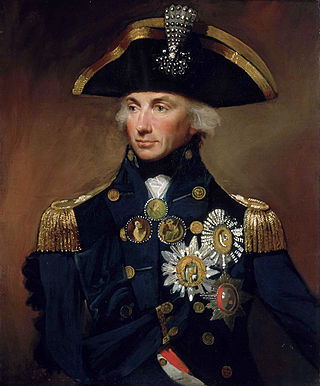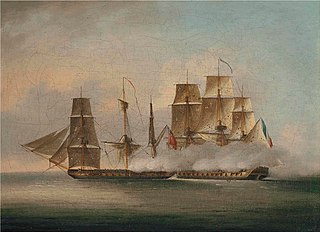
The Battle of Trafalgar was a naval engagement that took place on 21 October 1805 between the British Royal Navy and the combined fleets of the French and Spanish Navies during the War of the Third Coalition of the Napoleonic Wars (1803–1815).

Earl Nelson, of Trafalgar and of Merton in the County of Surrey, is a title in the Peerage of the United Kingdom. It was created on 20 November 1805 for the Rev. William Nelson, 2nd Baron Nelson, one month after the death of his younger brother Vice-Admiral Horatio Nelson, 1st Viscount Nelson, the famous naval hero of the Napoleonic Wars and victor of the Battle of Trafalgar of 21 October 1805. The title is extant, the present holder being Simon Nelson, 10th Earl Nelson, who has an heir apparent. The family seat of Trafalgar House in Wiltshire was sold in 1948 by Edward Nelson, 5th Earl Nelson.

Vice Admiral Cuthbert Collingwood, 1st Baron Collingwood was an admiral of the Royal Navy, notable as a partner with Lord Nelson in several of the British victories of the Napoleonic Wars, and frequently as Nelson's successor in commands.

Trafalgar Day is the celebration of the victory won by the Royal Navy, commanded by Vice-Admiral Horatio Nelson, over the combined French and Spanish fleets at the Battle of Trafalgar on 21 October 1805.

HMS Agamemnon was a 64-gun third-rate ship of the line of the British Royal Navy. She saw service in the American Revolutionary War, French Revolutionary, and Napoleonic Wars and fought in many major naval battles. She is remembered as Horatio Nelson's favourite ship, and she was named after the mythical ancient Greek king Agamemnon, the first ship of the Royal Navy to bear the name.

Sir David Nicholas Cannadine is a British author and historian who specialises in modern history, Britain and the history of business and philanthropy. He is currently the Dodge Professor of History at Princeton University, a visiting professor of history at Oxford University, and the editor of the Oxford Dictionary of National Biography. He was president of the British Academy between 2017 and 2021, the UK's national academy for the humanities and social sciences. He also serves as the chairman of the trustees of the National Portrait Gallery in London and vice-chair of the editorial board of Past & Present.

HMS Royal Sovereign was a 100-gun first-rate ship of the line of the Royal Navy, which served as the flagship of Admiral Collingwood at the Battle of Trafalgar. She was the third of seven Royal Navy ships to bear the name. She was launched at Plymouth Dockyard on 11 September 1786, at a cost of £67,458, and was the only ship built to her design. Because of the high number of Northumbrians on board the crew were known as the Tars of the Tyne.

In the Battle of Cape Finisterre off Galicia, Spain, the British fleet under Admiral Robert Calder fought an indecisive naval battle against the combined Franco-Spanish fleet which was returning from the West Indies. In the ensuing battle the British captured two Spanish ships of the line, but failed to prevent the joining of French Admiral Pierre de Villeneuve's fleet to the squadron of Ferrol and to strike the shattering blow that would have freed Great Britain from the danger of an invasion. Calder was later court-martialled and severely reprimanded for his failure and for avoiding the renewal of the engagement on 23 and 24 July. At the same time, in the aftermath Villeneuve elected not to continue on to Brest, where his fleet could have joined with other French ships to clear the English Channel for an invasion of Great Britain.

The Battle of Cape Ortegal was the final action of the Trafalgar campaign, and was fought between a squadron of the Royal Navy and a remnant of the fleet that had been defeated earlier at the Battle of Trafalgar. It took place on 4 November 1805 off Cape Ortegal, in north-west Spain and saw Captain Sir Richard Strachan defeat and capture a French squadron under Rear-Admiral Pierre Dumanoir le Pelley. It is sometimes referred to as Strachan's Action.

Horatio Nelson, 1st Viscount Nelson (1758–1805) was a British flag officer in the Royal Navy famous for his participation in the Napoleonic Wars, most notably in the Battle of Trafalgar, during which he was killed. He was responsible for several famous victories that helped to secure British control of the seas, both securing Britain from French invasion and frustrating Napoleon's imperial ambitions. After his death during his defeat of the combined French and Spanish fleets at Trafalgar, there was a public outpouring of grief. Nelson was accorded a state funeral and was buried in St Paul's Cathedral.

Horatio Nelson, 1st Viscount Nelson, 1st Duke of Bronté, was one of the leading British flag officers in the Royal Navy of the French Revolutionary and Napoleonic Wars, responsible for several important victories over the French and Spanish navies during a time of crisis for the country. He was widely lauded for his success, and praised for his skill and daring. After his death during the Battle of Trafalgar, he became revered as a British hero, and his fame reached new heights. Large numbers of monuments and memorials have been created in his honour, and he has continued to influence British culture and society.
The 1805 Club was founded in 1990 to accomplish three objectives. To assist in the preservation of monuments and memorials relating to Vice- Admiral Lord Horatio Nelson and seafarers of the Georgian era. To promote research into the Royal Navy of the Georgian period, and especially of Vice Admiral Lord Nelson. To organize cultural and historical events.

Captain George Miller Bligh (1780–1834) was an officer of the Royal Navy, who saw service during the French Revolutionary and Napoleonic Wars, eventually rising to the rank of Captain. He was present aboard HMS Victory at the Battle of Trafalgar, and was badly wounded during the action. He was taken below and was present in the cockpit at the death of Vice-Admiral Horatio Nelson.

The Trafalgar campaign was a long and complicated series of fleet manoeuvres carried out by the combined French and Spanish fleets; and the opposing moves of the Royal Navy during much of 1805. These were the culmination of French plans to force a passage through the English Channel, and so achieve a successful invasion of the United Kingdom. The plans were extremely complicated and proved to be impractical. Much of the detail was due to the personal intervention of Napoleon, who as a soldier rather than a sailor failed to consider the effects of weather, difficulties in communication, and the Royal Navy. Despite limited successes in achieving some elements of the plan the French commanders were unable to follow the main objective through to execution. The campaign, which took place over thousands of miles of ocean, was marked by several naval engagements, most significantly at the Battle of Trafalgar on 21 October, where the combined fleet was decisively defeated, and from which the campaign takes its name. A final mopping up action at the Battle of Cape Ortegal on 4 November completed the destruction of the combined fleet, and secured the supremacy of the Royal Navy at sea.

Vice-Admiral Horatio Nelson, 1st Viscount Nelson, 1st Duke of Bronte was a British flag officer in the Royal Navy. His inspirational leadership, grasp of strategy and unconventional tactics brought about a number of decisive British naval victories during the French Revolutionary and Napoleonic Wars. He is widely regarded as one of the greatest naval commanders in history. His victory on 21 October 1805 at the Battle of Trafalgar led to British naval supremacy over the next century and beyond.

This Bibliography covers sources for Royal Navy history through the 18th and 19th centuries. Some sources may be duplicated in sections when appropriate. Among the contemporary and earlier historical accounts are primary sources, historical accounts, often derived from letters, dispatches, government and military records, captain's logs and diaries, etc., by people involved in or closely associated to the historical episode in question. Primary source material is either written by these people or often collected, compiled, and/or written and published by other editors also, sometimes many years after the historical subject has passed. Primary sources listed in this bibliography are denoted with an uppercase bold ' (P) before the book title. Publications that are in the public domain and available online for viewing in their entirety are denoted with E'Book.

The action of 10 August 1805 was a minor naval engagement between two frigates of the British Royal Navy, HMS Phoenix and the French Navy Didon as part of the Napoleonic wars. After an hour of action Didon surrendered to Phoenix.
Max Adams is a British author, archaeologist., television presenter, and woodsman. His books cover a wide range of subjects from British history, to Arboriculture, and even his own novel. He currently manages his own young woodland in the north of England and has set up a not-for-profit partnership called "Woods for the Trees", which aims to bring together: people who would like to help cultivate healthy woodlands, with unused land that needs people's input and time. Adams also co-founded, and helps to organise, an archaeological adult-education program called "The Bernician Studies Group" who, among other pursuits, have performed an archaeological survey of monastic sites in Donegal

Vice-Admiral Horatio Nelson, 1st Viscount Nelson, was given a state funeral in London on 9 January 1806. It was the first to be held at St Paul's Cathedral and was the grandest of any non-royal person to that date. Nelson was shot and killed on 21 October 1805, aged 47, aboard his flagship, HMS Victory, during the Battle of Trafalgar, part of the Napoleonic Wars. The successful outcome of the battle against a larger Franco-Spanish fleet, secured British naval supremacy and ended the threat of a French invasion of the United Kingdom. Nelson's previous victories meant that he was revered as a national hero and news of his death was met with near universal shock and mourning. The scale of his funeral was not only an expression of public sentiment, but also an attempt by the British Government to improve the perception of its prosecution of the war.

Nelson Boarding the San Josef is an 1829 history painting by the British artist George Jones. It depicts the boarding and capture of the Spanish ship-of-the-line San Josef by the British Royal Navy at the Battle of Cape St Vincent on 14 February 1797. It emphasises the role played by Horatio Nelson, the future victor of the Battle of the Nile and Battle of Trafalgar.


















